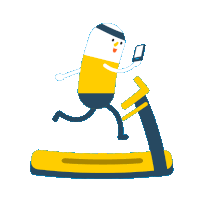

Welcome to the world of Kroc Rows, an exercise that transcends conventional strength training. Named after the legendary powerlifter Matt Kroc, this unique variation of the dumbbell row has become a staple in the fitness community. In this in-depth exploration, we will dissect the intricacies of Kroc Rows, covering proper form, the multitude of benefits they offer, and the specific muscles they target.
Kroc Rows derive their name from Matt "Kroc" Kroczaleski, a renowned powerlifter. This exercise is essentially an intensified version of the traditional dumbbell row, designed to maximize muscle engagement and promote substantial gains.
Achieving the correct grip and stance is foundational to mastering Kroc Rows. With a firm grip on the dumbbell, adopt a staggered stance for stability. Hinge at the hips, ensuring a straight back, and lift the dumbbell with controlled precision.
Emphasizing a complete range of motion is critical. Allow the dumbbell to hang fully before pulling it towards your hip. At the peak of the movement, squeeze your shoulder blades together, intensifying the contraction of the targeted muscles.
Sync your breathing with the motion: inhale as you lower the dumbbell and exhale forcefully during the lift. This coordination enhances stability and ensures optimal oxygen flow to the muscles.
Kroc Rows shine in their ability to activate and stimulate the latissimus dorsi, fostering the development of a broad and sculpted back.
Beyond the lats, Kroc Rows engage the rhomboids and trapezius, contributing to a well-defined upper back and improved posture.
Kroc Rows are a unilateral exercise, addressing one side of the body at a time. This not only corrects muscle imbalances but also enhances overall strength and stability.
The continuous tension on the grip fortifies the forearm and improves overall grip strength, a benefit that extends to various other lifting exercises.
One of the most significant advantages of Kroc Rows is their simplicity. Requiring only a dumbbell, they are a convenient addition to home workouts or busy gym sessions.
In a short span, Kroc Rows deliver a full-body workout. They efficiently target multiple muscle groups, making them a time-effective choice for those with busy schedules.
The primary muscle activated during Kroc Rows, the latissimus dorsi, is pivotal for achieving the coveted V-shape appearance of the back.
Engagement of the rhomboids and trapezius enhances upper back strength and aesthetics, contributing to a well-rounded physique.
The pulling motion of Kroc Rows activates the biceps and forearms, providing additional benefits for arm development.
Maintaining stability during the exercise requires core engagement, indirectly working the abdominal muscles.
Perfecting the grip and stance is crucial for maximizing the effectiveness of Kroc Rows. Ensure a secure grip and experiment with foot placement to find the stance that provides optimal stability.
To intensify the impact on your muscles, focus on refining your range of motion. Emphasize the full stretch at the bottom of the movement and a controlled contraction at the top.
Mastering the coordination of breathing enhances overall control and ensures that your muscles receive a consistent supply of oxygen throughout the exercise.
Kroc Rows, as a compound movement, contribute to increased caloric expenditure, making them valuable for both muscle development and fat loss goals.
The demanding nature of Kroc Rows necessitates heightened mental focus. Developing a strong mind-muscle connection enhances the effectiveness of the exercise.
To keep your workouts engaging, experiment with different variations of Kroc Rows. This could involve adjusting the grip, trying different dumbbell weights, or incorporating pauses at specific points in the movement.
For those seeking an extra challenge, pairing Kroc Rows with complementary exercises in supersets can elevate the intensity of your workout. This approach also enhances overall calorie burn.
Attentiveness to your body's response is crucial. If you experience discomfort beyond normal muscle fatigue, reassess your form or seek guidance from a fitness professional.
Optimal results with Kroc Rows come from gradual progression. Start with a weight that challenges you while maintaining proper form, and incrementally increase the weight as you gain proficiency.
The ideal frequency for incorporating Kroc Rows into your routine depends on your overall workout plan and individual recovery capacity. Begin with 1-2 sessions per week, adjusting based on your body's response.
Kroc Rows are adaptable to various fitness levels. Beginners can start with lighter weights, gradually progressing as they become more comfortable. Advanced lifters can challenge themselves with heavier weights and advanced techniques.
In conclusion, Kroc Rows are more than just an exercise; they are a journey toward a stronger, more sculpted physique. By refining your technique, unlocking additional benefits, and fine-tuning your routine, you can maximize the potential of Kroc Rows in your fitness journey.
.png)